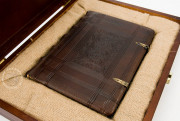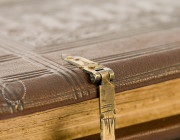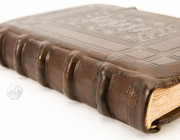The manuscript includes two artistically consistent parts:
1. Kalendarium der Diozese Utrecht.
"Januarius loumaet due heuet XXXI dage die mane XXX. Jares dach. Siluester bisscop"
2. Geert Groote, Getijdenboek.
"Hier begint ons[er] vrouwe[n] getide. Here doe op mine lippe[n]. in alre tonghen menich foudicheit uergader heues in eenheit des ghelouen. Lo[uet bladelike den heren]" – the text in the manuscript is cut; it was completed on the basis of literature.
The Art of the Book
The book was written by one copyist using Bastarda font. It contains a lot of (almost each sheet) unique and very beautiful colorful and golden initials, as well as borders, with floral and figural decorations. These all indicate the Renaissance culture's clear influence.
The language used in the book suggests that the breviary was made in the eastern Netherlands, probably in the Utrecht district. The cover was probably made by a bookbinder named Jacobus, as the writing on the bottom part of the cover suggests. In 1687 the book, along with other books, was taken over by the National and University Library in Królewiec.
Binding description
Characteristic of the time in which the manuscript was written: a board, brown embossed leather, and two brass clasps protecting the book against dust and sheet deformation.
We have 1 facsimile edition of the manuscript "Dutch Breviary in Toruń": Brewiarz Staroniderlandzki facsimile edition, published by Orbis Pictus, 2008
Request Info / Price










